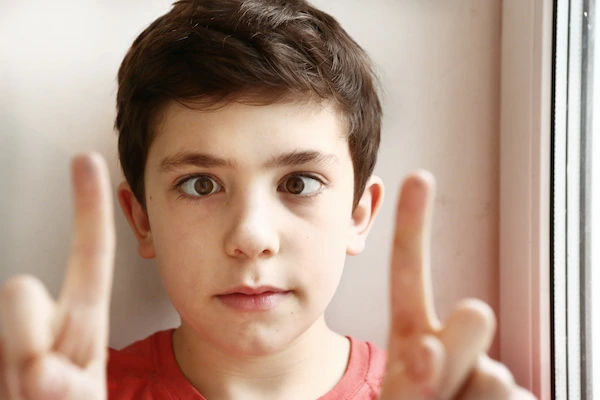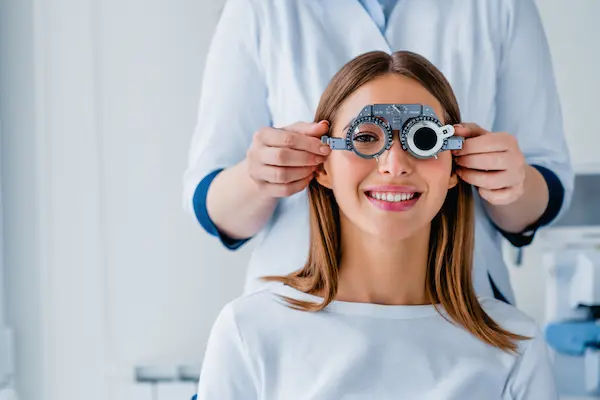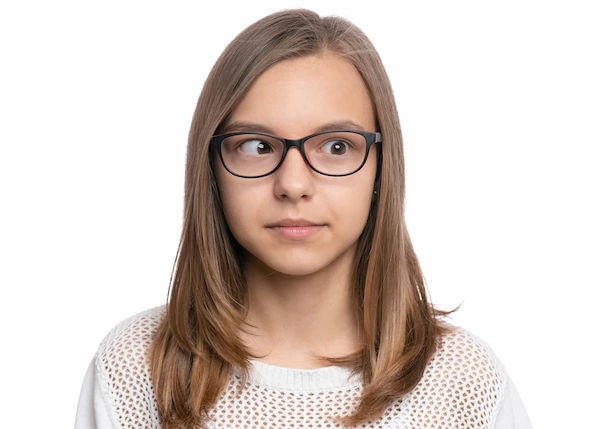Squint and Lazy Eye in Children: A Parent's Guide to Early Detection and Treatment
Learn how to detect and treat squint (strabismus) and lazy eye (amblyopia) in children. Discover symptoms, causes, and effective treatments—from glasses and patching to surgery—for healthy lifelong vision.

Written by Dr. J T Hema Pratima
Reviewed by Dr. Rohinipriyanka Pondugula MBBS
Last updated on 29th Sep, 2025
.webp?tr=q-80,f-webp,w-350,dpr-2,c-at_max 700w)
Introduction
As a parent, every milestone your child reaches is a moment of joy. But when it comes to their vision, subtle signs can sometimes cause worry. Two of the most common eye conditions in children are squint (often called crossed eyes) and lazy eye. While these terms are sometimes used interchangeably, they are distinct conditions that are often related. Understanding the difference is the first step towards ensuring your child’s healthy visual development. A squint, medically known as strabismus, is a problem with eye alignment where the eyes point in different directions. A lazy eye, or amblyopia, is a problem with the brain's ability to recognize sight from one eye, leading to poor vision that cannot be fully corrected with glasses alone. The crucial thing to know is that both conditions are highly treatable, especially when caught early. This comprehensive guide will walk you through everything you need to know—from spotting the early signs to exploring the most effective lazy eye and squint treatments, empowering you to take proactive steps for your child’s eye health.
Understanding the Basics: What Are Squint and Lazy Eye
Before diving into symptoms and treatments, it's vital to clearly distinguish between these two conditions. Think of it as a problem with the hardware versus a problem with the software.
What is Strabismus (Squint)?
Strabismus, commonly known as a squint or crossed eyes, is a condition where the eyes are misaligned. The muscles that control eye movement don't work together, causing one eye to look straight ahead while the other may turn inward (esotropia), outward (exotropia), upward (hypertropia), or downward (hypotropia). This misalignment can be constant or intermittent, appearing only when the child is tired, unwell, or focusing on a nearby object. The brain receives two different images, which can lead to double vision. In children, the brain is remarkably adaptive and may learn to ignore the image from the misaligned eye to avoid confusion. This is where the link to a lazy eye begins.
What is Amblyopia (Lazy Eye)?
Amblyopia, or lazy eye, is not a problem with the eye's structure itself but a developmental issue in the brain's visual cortex. When the brain consistently favors one eye over the other due to a difference in clarity or alignment, the neural pathways for the weaker eye are not properly stimulated. Over time, the brain effectively "switches off" the input from the weaker eye, leading to a permanent reduction in vision. The eye may look perfectly normal, which is why lazy eye is often called a "hidden" disability.
The Critical Link Between Squint and Lazy Eye
The most common cause of lazy eye is a squint. When the eyes are misaligned, the brain is faced with two conflicting images. To see clearly, it suppresses the image from the turned eye. This suppression, if prolonged during the critical period of visual development (from birth to around 7-8 years), causes amblyopia to develop in the misaligned eye. However, a lazy eye can also be caused by a significant difference in prescription between the two eyes (anisometropia) or a cloudiness in the eye lens (cataract), even if the eyes are perfectly aligned.
Health topic carousel:
Doctor's speciality: Ophthalmology
Text: Consult a Ophthalmologist for the best advice
Spotting the Signs; Symptoms of Squint and Lazy Eye in Your Child
Early detection is the cornerstone of successful treatment. While some signs are obvious, others require a more watchful eye.
Visible Signs of a Squint (Strabismus)
The most apparent symptom is a visible misalignment of the eyes. You might notice:
- One eye turning in, out, up, or down consistently or intermittently.
- The misalignment is more noticeable when the child is daydreaming, tired, or looking in a particular direction.
- The child tilting their head or turning their face to use their eyes together.
- Squinting or closing one eye, especially in bright sunlight, to block out the second image and avoid double vision.
Subtle Indicators of a Lazy Eye (Amblyopia)
Since the eyes may appear normal, detecting a lazy eye can be trickier. Look for:
- Poor depth perception, leading to clumsiness, bumping into things, or difficulty with activities like catching a ball.
- Favoring one side of the body.
- Frequent eye rubbing or blinking.
- Struggling with visual tasks like reading or noticing that the child brings objects very close to their face to see.
- A minor, sometimes unnoticeable, turning of an eye.
When to Be Extra Vigilant: High-Risk Periods
While these conditions can develop at any time, the critical period for visual development is from birth to age 7-8. Be particularly observant during infancy and the preschool years. If you have a family history of squint or lazy eye, your child is at a higher risk, and regular eye check-ups are essential.
Root Causes: Why Do Squint and Lazy Eye Develop?
Understanding the causes can help demystify the condition and guide treatment.
Common Causes of Squint
- Refractive Errors: Uncorrected farsightedness (hyperopia) can cause the eyes to over-focus and turn inward.
- Muscle Imbalance: Problems with the eye muscles that control movement.
- Genetics: A family history of strabismus increases the risk.
- Neurological Conditions: In some cases, issues affecting the brain's control of eye muscles can be a cause.
- Other Health Conditions: Conditions like Down syndrome or cerebral palsy can be associated with a squint.
How a Lazy Eye Develops
Amblyopia develops as a consequence of the brain not receiving a clear image from one eye. The primary triggers are:
1. Strabismic Amblyopia: Caused by a misaligned squint.
2. Refractive Amblyopia: Caused by a significant difference in prescription between the two eyes.
3. Deprivation Amblyopia: Caused by something obstructing light from entering the eye, such as a congenital cataract or a droopy eyelid (ptosis). This is the least common but most severe form.
Consult a Ophthalmologist for the best advice
Getting a Diagnosis: The Pediatric Eye Examination
If you suspect any issue, a professional diagnosis is crucial. If symptoms like eye misalignment or poor vision persist, consult a pediatric ophthalmologist online with Apollo24|7 for an initial assessment and guidance.
What to Expect During the Eye Check-up
A pediatric eye exam is tailored to the child's age. The doctor will:
- Test visual acuity using age-appropriate charts (pictures, letters).
- Perform a refraction test to determine the correct prescription for glasses, often using a handheld instrument or eye drops (cycloplegic refraction) to get an accurate measurement.
- Assess eye alignment and movement.
- Examine the health of the internal and external structures of the eye.
- The Importance of Vision Screening in Schools
School vision screenings are a valuable first step, but they are not a substitute for a comprehensive eye exam by a specialist. They can help identify children who need further evaluation.
Treatment Options: Correcting Squint and Lazy Eye
The good news is that with early intervention, the success rate of treatment is very high. The goals are to ensure good vision in each eye and to promote binocular vision (the ability to use both eyes together).
Non-Surgical Treatments: The First Line of Defense
These are often the first steps in managing both conditions.
Prescription Glasses and Contact Lenses
If a refractive error is the cause, simply wearing the correct glasses can often straighten the eyes, especially in cases of accommodative esotropia (crossing due to farsightedness). For a lazy eye caused by a refractive error, glasses provide a clear image to stimulate the brain.
Eye Patching Therapy for Amblyopia
This is the most common lazy eye treatment. By placing a patch over the stronger eye for several hours a day, the brain is forced to use the weaker eye, strengthening its visual pathway. Consistency is key, and the schedule will be set by the ophthalmologist.
Vision Therapy and Eye Exercises
Specific exercises can help improve eye coordination and focusing skills. This is often used in conjunction with other treatments.
Surgical Intervention for Squint Correction
If glasses alone do not correct the squint, surgery may be recommended. The procedure involves adjusting the tension of the eye muscles to realign the eyes. It is a common and safe procedure. It's important to note that surgery corrects the alignment, but any existing amblyopia must still be treated with patching or other methods.
Atropine Eye Drops: An Alternative to Patching
For some children who resist patching, atropine eye drops can be used. A drop is placed in the stronger eye once a weekend to temporarily blur its vision, encouraging the use of the weaker eye—a method known as penalization therapy.
The Crucial Role of Early Intervention
The brain's visual system is most plastic during early childhood. This neuroplasticity means it's highly adaptable and responsive to treatment. After the age of 7-8, the visual system becomes less malleable, making treatment more challenging and less effective. This is why diagnosing and treating squint and lazy eye as early as possible is non-negotiable for the best visual outcome. Delaying treatment can lead to permanent vision loss in the amblyopic eye.
Conclusion: Empowering Your Child's Vision
Navigating a diagnosis of squint or lazy eye can feel overwhelming, but armed with the right information, you can be a powerful advocate for your child's eye health. Remember, these are common and highly treatable conditions. The key is to stay vigilant, trust your instincts as a parent, and seek professional help at the first sign of concern. The goal of treatment is not just cosmetic alignment but the lifelong gift of clear, comfortable, and functional binocular vision. By partnering with a qualified pediatric ophthalmologist and adhering to the treatment plan, you are giving your child the best possible chance for a future with healthy vision. If you have any doubts about your child's eye alignment or vision, don't wait. Book a physical visit to a pediatric ophthalmologist with Apollo24|7 for a comprehensive evaluation.
Consult a Ophthalmologist for the best advice
Consult a Ophthalmologist for the best advice
Dr. Padmini S
Ophthalmologist
4 Years • MBBS,MS
Bengaluru
Apollo Medical Center, Marathahalli, Bengaluru
Dr. Akashdipta Saha
Ophthalmologist
4 Years • MBBS, MD(Ophthalmology), Fellowship in Retina & Vitreous
Delhi
AIIMS, Delhi

Dr. Pratik Ranjan Sen
Ophthalmologist
20 Years • MBBS; MS; DO
Chennai
Apollo Hospitals Greams Road, Chennai
(25+ Patients)

Dr. Arpita Agrawal
Ophthalmologist
20 Years • MBBS MS FLUPEI
Bhopal
Apollo Sage Hospitals, Bhopal

Dr Monica Gour
Ophthalmologist
9 Years • MS(Ophthalmology) Fellowship in Cornea
Lucknow
Apollomedics Super Speciality Hospital, Lucknow
Consult a Ophthalmologist for the best advice
Dr. Padmini S
Ophthalmologist
4 Years • MBBS,MS
Bengaluru
Apollo Medical Center, Marathahalli, Bengaluru
Dr. Akashdipta Saha
Ophthalmologist
4 Years • MBBS, MD(Ophthalmology), Fellowship in Retina & Vitreous
Delhi
AIIMS, Delhi

Dr. Pratik Ranjan Sen
Ophthalmologist
20 Years • MBBS; MS; DO
Chennai
Apollo Hospitals Greams Road, Chennai
(25+ Patients)

Dr. Arpita Agrawal
Ophthalmologist
20 Years • MBBS MS FLUPEI
Bhopal
Apollo Sage Hospitals, Bhopal

Dr Monica Gour
Ophthalmologist
9 Years • MS(Ophthalmology) Fellowship in Cornea
Lucknow
Apollomedics Super Speciality Hospital, Lucknow
More articles from Strabismus
Frequently Asked Questions
Can my child outgrow a squint or lazy eye?
No, these conditions do not resolve on their own. While some infants may have intermittent crossing that resolves, a persistent squint or any suspicion of a lazy eye requires professional evaluation. Delaying treatment can lead to permanent vision loss.
What is the best age for squint surgery?
There is no single 'best' age; it depends on the type and severity of the squint. Surgery can be performed as early as a few months old if the squint is large and constant. The ophthalmologist will recommend the optimal timing based on your child's specific condition.
How many hours a day should my child wear an eye patch for lazy eye?
The patching schedule is highly individualized. It can range from 2 to 6 hours a day during waking hours. Your ophthalmologist will prescribe the exact duration based on the severity of the amblyopia and your child's age. Strict adherence is crucial for success.
Are there any successful lazy eye treatments for adults?
While treatment is most effective in childhood, recent research shows that some degree of improvement is possible in adults through vision therapy and perceptual learning, especially with dedicated practice. However, results are typically more limited than in children.
Will wearing glasses weaken my child's eyes?
This is a common myth. Glasses do not weaken eyes. They correct refractive errors to provide a clear image, which is essential for healthy visual development. In cases of squint and lazy eye, they are a fundamental part of the treatment.


